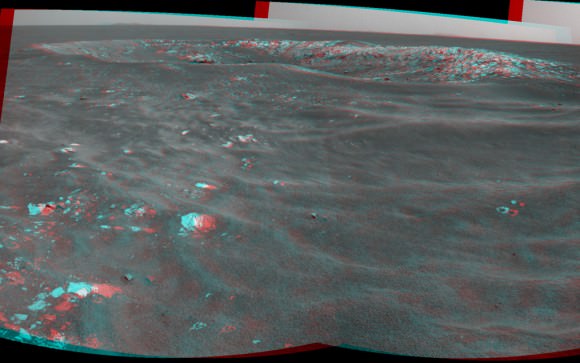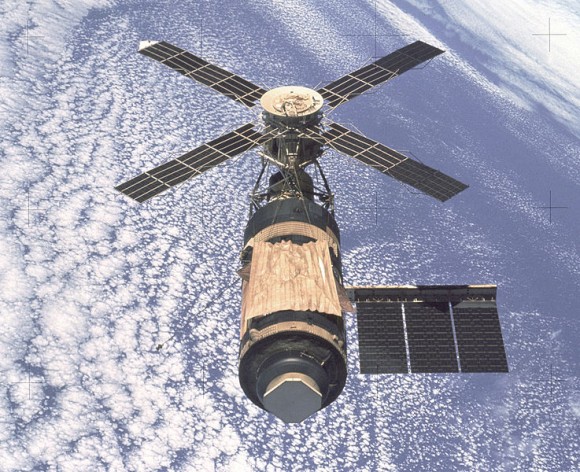[/caption]
With her most recent drive of 482 feet (146.8 meters) on June 1, 2011 (Sol 2614), NASA’s Opportunity Mars Rover has zoomed past the unimaginable 30 kilometer (18,64 miles) mark in total odometry since safely landing on Mars nearly seven and one half years ago on Jan 24, 2004. That’s 50 times beyond the roughly quarter mile of roving distance initially forseen.
Opportunity is now 88 months into the original 3 month mission “warranty” planned by NASA and the rover team. That’s over 29 times beyond the original design lifetime and an achievement that no one on the rover teams ever expected to observe.
And Opportunity is still going strong, in good health and has abundant solar power as she continues driving on her ambitious overland trek across the martian plains of Meridiani Planum. She is heading to the giant Endeavour crater, some 22 km (14 miles) in diameter.

This stereo view of Skylab Crater was captured by Opportunity on Mars on Sol 2594, or May 12, 2011, along the rovers route to giant Endeavour Crater. This young crater is about 30 feet (9 meters) in diameter.and was likely formed within the past 100,000 years. Credit: NASA/JPL-Caltech
At this point Endeavour is barely 2 miles (3.5 km) away since Opportunity departed from Santa Maria Crater in March 2011. Landfall at Endeavour is expected sometime later this year.
Endeavour is a long awaited and long sought science target because it is loaded with phyllosilicate clay minerals. These clays have never before been studied and analyzed first hand on the red planets surface.

This view of Skylab Crater was captured by Opportunity’s navigation camera on Mars on Sol 2594, or May 12, 2011, along the rovers route to giant Endeavour Crater. This young crater is about 30 feet (9 meters) in diameter. The blocks of material ejected from the crater-digging impact sit on top of the sand ripples near the crater. This suggests, from the estimated age of the area's sand ripples, that the crater was formed within the past 100,000 years. The dark sand inside the crater attests to the mobility of fine sand in the recent era in this Meridiani Planum region of Mars. The rover view spans 216 degrees from northwest on the right to south on the right. Credit: NASA/JPL-Caltech
Phyllosilicate clays formed in neutral watery environments, which are much more conducive to the formation of life compared to the highly acidic environments studied up to now by Spirit and Opportunity. NASA’s Curiosity rover is due to land on Mars in 2012 at a site the science team believes is rich in Phyllosilicates.
In recent weeks, Opportunity has passed by a series and small young craters as she speeds to Endeavour as fast as possible. One such crater is named “Skylab”, in honor of America’s first manned Space Station, launched in 1973.
Now whip out your 3 D glasses and check out NASA’s newly released stereo images of “Skylab” and another named “Freedom 7” in honor of Alan Shepard’s flight as the first American in space. Be sure to also view Opportunity’s dance steps in 3 D performed to aid backwards driving maneuvers on the Red planet

Opportunity recorded this stereo view of a crater informally named Freedom 7 shortly before the 50th anniversary of the first American in space: astronaut Alan Shepard's flight in the Freedom 7 spacecraft on May 5, 1961. Opportunity took this image on Sol 2585 on Mars on May 2, 2011. The crater is about 25 meters (82 feet) in diameter. It is the largest of a cluster of about eight craters all formed just after an impactor broke apart in the Martian atmosphere perhaps 200,000 years ago. Credit: NASA/JPL-Caltech
“Skylab” is about 9 meters (30 feet) in diameter. The positions of the scattered rocks relative to sand ripples suggest that Skylab is young for a Martian crater. Researchers estimate it was excavated by an impact within the past 100,000 years.
“Freedom 7” crater is about 25 meters (82 feet) in diameter. During her long overland expedition, Opportunity is examining many craters of diverse ages at distant locales to learn more about the past history of Mars and how impact craters have changed over time.
Opportunity was just positioned at a newly found rock outcrop named “Valdivia” and analyzing it with the robotic arm instruments including the Microscopic Imager and the Alpha Particle X-ray Spectrometer (APXS).

A dance-step pattern is visible in the wheel tracks near the left edge of this scene recorded in stereo by the navigation camera during Sol 2554 on Mars (April 1, 2011). The pattern comes from use of a new technique for Opportunity to autonomously check for hazards in its way while driving backwards. For scale, the distance between the parallel tracks of the left and right wheels is about 1 meter (about 40 inches). Credit: NASA/JPL-Caltech

Photo taken by departing Skylab 4 crew in Feb. 1974. Credit: NASA


Referring to the sixth paragraph:
I don’t bloody believe they actually said that!
You are an idiot.
And you are violating UT’s comment policy!
HeadAroundU, it is UT policy to avoid calling people names on the forums. I usually ban people for this. However, I understand you are a frequent reader here. Your comment has been removed, please do not make me take notice of your comments again.
So, how should I react when someone is acting like you know what? He is trying to ban the word “belief” which is an extremist move.
I don’t like the option of ignoring because things must be balanced out.
If he is not gonna stop, I’m planning a next strategy. 🙂
http://en.wikipedia.org/wiki/Epistemology#Belief
http://en.wikipedia.org/wiki/Belief
Head,
Part of the main problem with any layperson’s understanding of the sciences is shared words meaning entirely different and at times, opposite, things.
All structured groupings of knowledge have shared words without shared meanings. The specific meaning within that structure needs translation when taken from that specific structure into the common shared structure. Idiom in, idiot out, so to speak
It might have been convenient to use these terms in the past, indeed it was correct usage of the term ‘believe’ since in those days, in what sciences there were, the religion of Abraham and its many branches and offshoots ruled the dialog and the settings. It was required usage, not optional, then and there.
Currently there is not a need for the word ‘belief’ or its cognates within scientific discussions any more than there is a reason to use, incorrectly, other terms which have a different or diametrically opposite meaning ‘outside’ the discourse.
To use this term, fraught with meanings, outside the structure’s scope and with the additional baggage from different structures –into the structure of any science is to lack common sense and sufficient wit to use a less encumbered term.
But, be all this what it may, the effort to remove this term, and several others, from the structures of science has been fruitless for centuries and will continue to remain unbearable to many of us within the sciences, pun intended, for the precipitable future.
Mary
Just like there is no need to use the word, there is no need to ban it.
The whole philosophy of separating science and “religion” is just wrong. It doesn’t bring anything good, while a fusion can, it doesn’t have to be a direct fusion…
LOL, are you saying that Tammy lacks common sense and sufficient wit?
go little Rover!..now part of my life
I believe this thread wandered WAY off topic…. (sigh)